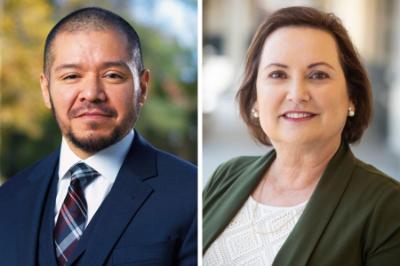
Amid increasing recognition of the value of multilingualism and the growth of world language and dual language immersion teaching in California, the LMU School of Education has been chosen as the Greater Los Angeles & Inland Empire site for the California World Language Project (CWLP). Beginning this year, LMU will lead the largest region of the state- and federally funded effort to enhance students’ multilingual literacy skills and educational outcomes through professional development programs supporting world language educators, as well as research on second language acquisition and advocacy for world language programs.
“Los Angeles has one of the largest concentrations of languages in the world,” says William Perez, Ph.D., professor of educational leadership and administration and the co-principal investigator of the CWLP site along with Magaly Lavadenz, Ph.D., SOE’s Leavey Presidential Endowed Chair in Moral and Ethical Leadership and executive director of the Center for Equity for English Learners. “We want to connect with that defining feature of our region and support the individuals who are at the forefront of ensuring that multilingualism continues to thrive with the next generation and beyond.”

CWLP is part of the California Subject Matter Project (CSMP) network, which aims to improve student learning through discipline-specific sustained professional learning and leadership programs for educators. LMU is also a site for the California Reading and Literature Project (CRLP), part of the network, under Lavadenz’s leadership. “These two subject matter projects at SOE will be synergistic in many ways,” Perez notes. “CWLP recognized that we have both the expertise and the track record of working across the public, charter, and Catholic school sectors, which gives us a large audience to support teachers through this work.”
The primary charge for LMU’s CWLP site will be professional development—helping world language and dual language educators learn about evidence-based best teaching practices. Among the biggest challenges these teachers face, Perez notes, is that traditional pedagogical models assume that learners of languages are being exposed for the first time. “In a region like Los Angeles where there is a concentration of multilingual-speaking individuals, there are going to be kids who come to these classrooms having grown up hearing the language, even if they’re not proficient at speaking it,” Perez says. “It’s important to take that diversity of experiences into account when students enroll in a language class.” The LMU site will also leverage SOE’s faculty expertise to assist world language teachers in integrating ethnic studies content in their teaching.
World languages haven’t always been embraced in California or the nation at large. Perez cites the late Joshua Fishman, a renowned social linguist and bilingual scholar with whom he was a co-author on the 2006 book Developing Minority Language Resources: The Case of Spanish in California. “In the 1960s, he wrote something that continues to resonate for those of us who do work around language—that the United States was a country where languages come to die,” Perez says. “Too often, immigrants come here and by the second or third generation, their children and grandchildren can no longer communicate in the language of their family’s country of origin.”
But that has begun to change, Perez says, and California has become a national leader in supporting education that promotes the unique perspectives and cross-cultural dialogues that depend on multilingualism to thrive. Proposition 58, approved by California voters in 2016, repealed the English-only requirement passed by the state’s voters in 1998 and gave public schools more control over dual-language acquisition programs. That has enabled the state to create an infrastructure for advancing multilingualism, Perez notes. The California Department of Education has established a goal of having half of all K-12 students participate in programs leading to proficiency in two or more languages by 2030. The State Seal of Biliteracy Program was established to recognize high school graduates who attain a high level of multilingual proficiency.
Language revitalization efforts are also on the rise in Native American communities throughout the U.S., Canada, and elsewhere, adds Perez, whose book Culturally Responsive Schooling for Indigenous Mexican Students, set to be published next spring, documents the experiences of students in California schools who speak English, Spanish, and one of three Indigenous languages: Zapotec, Mixtec or P'urhépecha. The book explores the students’ ethnoracial identities, Indigenous language use, and transnational practices, as well as how these factors influence school adjustment, academic achievement, and educational pathways.
In addition to his scholarship, Perez has firsthand experience with the value of promoting multilingualism. As an immigrant from El Salvador, his first language was Spanish. But he believes going through the public educational system at a time when multilingual programs were discouraged in California worked to his detriment. “When I was in school, the home language could be used only as a vehicle to get me to become English proficient — and I did become English proficient, but at the cost of Spanish, which I later had to relearn,” he says. “I was able to speak Spanish with my parents, siblings and extended family, but when I went to Mexico and started networking with other academic scholars doing work on immigration, I found myself not knowing how to say certain things.”
Serving as a co-principal investigator for the CWLP site at LMU brings Perez’s academic career full circle. As a first-year doctoral student at Stanford University more than two decades ago, he was a graduate assistant for the program, which was then called the California Foreign Language Project. The name change reflects the desire to avoid inadvertently “otherizing” individuals who speak languages besides English, and an understanding that multilingualism should be viewed as an inclusive field, Perez explains.
He notes that a substantial body of research supports the cognitive benefits of multilingualism, including an improved ability to learn new information and process complex concepts. Studies have also suggested other advantages — for example, as an undergraduate, Perez was involved in research that found that children who played an active role as translators for their monolingual parents not only achieved better academic outcomes, but also showed more advanced social skills.
Perez also points to the larger societal benefits. “There is a strong correlation between multilingualism and cultural competence, and in this time of polarization, it helps to facilitate better communication and understanding,” he says. “People who can navigate their way across cultures can be effective bridge builders locally and globally, which ultimately contributes to a thriving democracy where we can have debates and disagreements in a productive way.”